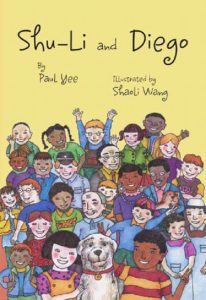Book Review: Shu-Li and Tamara by Paul Yee
 Shu-Li and Tamara is better than the sequel!
Shu-Li and Tamara is better than the sequel!
Recently I reviewed Shu-Li and Diego (2009), written by Paul Yee, which I believe is ideal for emerging readers and young ESL students. How does its predecessor, Shu-Li and Tamara (2008) fair? Let’s put it this way, it’s better than the sequel!
Shu-Li and Tamara was written by Paul Yee and illustrated by Shaoli Wang. The Shu-Li book series is based in Vancouver and is about a girl called Shu-Li and her friends, Tamara and Diego. Each of the books focuses on her friendship with one of the two friends.
The main part of the story is about Shu-Li and Tamara. Both Shu-Li and Tamara are new to Vancouver. Having joined their school near the end of the school term and having a different cultural attitude to the other kids, both girls are having problems making friends. Shu-Li suffers from bullying, and Tamara suffers from rumour-mongering. Because of their similar situation, Shu-Li and Tamara become friends. However, this friendship is jeopardized by one of the boys spreading a rumour that Tamara is a thief.
Shu-Li and Tamara is must read for any school classroom for several reasons. Firstly, the language and topics are perfect for ESL students and new immigrants. The English is realistic, yet easy enough to read. At the same time, the story isn’t a book for babies; it’s for slightly older kids that need something meatier to read.
This leads to my second reason for loving this book – it’s a great book for critical thinking! There are countless examples scattered throughout Shu-Li and Tamara of things that require inferencing and deduction in order to realise their greater significance. I feel so strongly about this that I’d like to quote an example from the book:
“Why, thank you. You’re very kind. That’s the nice thing I’ve heard in a long time.” (says Tamara’s mum to Shu-Li’s mum)
The beauty of lines like this is that Paul Yee offers no explanation. Why would Tamara’s mum say this? A ‘thank you’ would suffice, but the addition indicates a broader experience of her new life in Vancouver. It isn’t all sunshine and rainbows. People or organisations haven’t been kind to her until now. That’s sad, but only when you realise what Paul Yee’s hinting at.
Interestingly, Shu-Li and Tamara’s class are raising money for kids in some village in some African country, neither of which they can name, because of their ‘sympathy’ for poverty in foreign nations; yet, ironically, the kids in their class are shown to be completely intolerant and unsympathetic towards poverty among their classmates. This is a very realistic and important issue. One only needs to look at attitudes towards Vancouver’s homeless to see just that.
The third reason this book is a must for classrooms is that it reveals to everyone – new immigrants and young Vancouverites equally – the difficulties of moving to a new country. On the one level, we have the example of bullying and rumour-mongering. However, you don’t need to dig very deep to see the underlying racism that these characters and their families are experiencing. For example, some girls from Shu-Li’s class laugh at her mum’s English. As with Shu-Li and Diego, we also see the cultural conflict that can arise between immigrant parents and their children. Because of the difficult and reluctance for their parents to adapt to Canadian life and the English language, Shu-Li and Tamara constantly feel embarrassed by their parents, while at the same time are proud of them.
According to Paul Yee’s website, he was born in Saskatchewan, but grew up in Vancouver’s Chinatown area. You can see how aware Yee is of the differences between Chinese and Canadian values, and the conflict this can create between children and parents. At the same time, Yee does not judge any cultural attitudes – only the pressure on the child to appease both cultures, which is often impossible to achieve.
The geographical focus of Vancouver is pleasing and adds to the feel of the story. However, I can’t help but feel that the depictions are a little over-hyped, with a very New York-esque portrayal. Commercial Drive may have its pleasing points, but it isn’t exactly a place you’d want kids wandering around alone. What is more, Yee ignores the reality of the heavy traffic and huge distances between any good places that exist. Vancouver is no New York City!
Overall, I can’t help but praise this book. It’s a must-read for any young ESL student and new immigrant to Canada, particular to Vancouver. It is a wonderful book for any school classroom, and can be used to cover important topics such as peer-pressure, rumour-mongering, bullying, cultural conflicts, immigration, relationships between parents and kids, friendships, and poverty in Vancouver.


